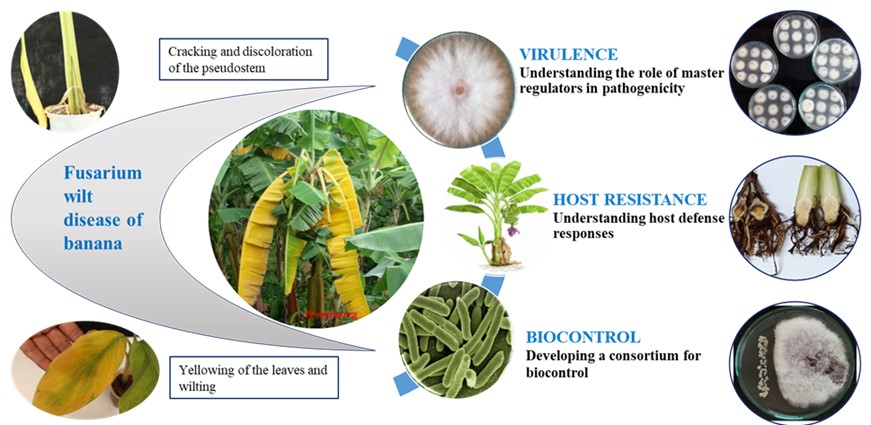



Assistant Professor
Publications
Group Members

Junior Project Assistant
Research

Understanding the molecular mechanisms of banana-Fusarium interaction
Fusarium wilt disease of banana is one of the most devastating diseases threatening banana production world over. This disease is caused by a soil fungal pathogen, Fusarium oxysporum f. sp. cubense (Foc). The interaction between Foc and banana is intricate and involves defense and counter-defense strategies. In order to decipher the molecular dialogue between these two organisms we identified one of the routes through which these signals are exchanged i.e. extracellular vesicles (EVs). The EVs secreted by Foc were characterized using electron microscopy, mass-spectrometry and DLS technique and found to be carrying important regulators of pathogenicity. We use both forward and reverse genetics to understand the pathogenicity in Foc and resistance in banana plants. An important transcriptional co-activator FocSge1 present on the core chromosome is known to regulate genes on the pathogenicity chromosomes of Foc. We generated knockouts of FocSge1 and showed that it has multiple roles to play in the process of conidiation, pigmentation, hydrophobicity and mycelium growth of Foc. Understanding the molecular regulation of FocSge1 and its downstream signalling resulting in a switch to pathogenic lifestyle in Foc is of our special interest.
Molecular players in resistance responses demonstrated by resistant cultivars of banana
Host resistance is the best strategy to manage Fusarium wilt disease of banana. Most of the cultivated varieties of banana are susceptible to Fusarium wilt and there are no suitable substitutes. Thus, it is necessary to understand the defense responses mounted by the resistant cultivars which can then be introgressed into the susceptible cultivars through molecular or conventional breeding. Among the several molecular players we focus on B cell lymphoma 2 (Bcl-2)-associated athanogene (BAG) family of co-chaperones those are evolutionary conserved and regulate cell death, growth and development. A genome-wide in silico analysis of the MusaBAG gene family revealed thirteen MusaBAG genes distributed on different chromosomes in banana. In addition to the BAG domain these proteins have a ubiquitin-like domain or a calmodulin binding motif. These genes are differentially regulated under abiotic and biotic stress conditions. Significance of this family of proteins in Fusarium wilt disease in banana is being explored.
Developing effective biocontrol strategies to manage Fusarium wilt disease
The ability of rhizospheric microbes to act as biocontrol agents against fungal pathogens and stimulate plant growth is due to one of mechanisms including antibiotic production, induced systemic resistance, competition for essential resources such as nutrients and space, and production of plant growth factors. We aim to understand these responses generated in rhizospheric microbes in presence of the host banana plant and fungal pathogen Foc. Understanding this tripartite interaction will aid in devising novel managing strategies
Dissertation & Project Students
Dissertation Students:
CEBS Project Students
Courses taken
External Links
UM-DAE Centre for Excellence in Basic Sciences
Nalanda Building, University of Mumbai, Vidyanagari, Mumbai 400098, India.
NEST/Outreach:+9186570 26481
NEST/Admissions:+9186570 26482
General Enquiries: info@cbs.ac.in
Admissions Queries:admissions@cbs.ac.in
Web: https://cbs.ac.in